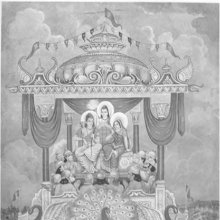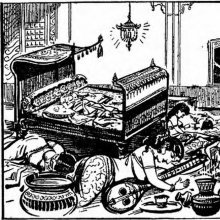Pushpakavimana, Puṣpakavimāna, Pushpaka-vimana: 2 definitions
Introduction:
Pushpakavimana means something in Hinduism, Sanskrit. If you want to know the exact meaning, history, etymology or English translation of this term then check out the descriptions on this page. Add your comment or reference to a book if you want to contribute to this summary article.
The Sanskrit term Puṣpakavimāna can be transliterated into English as Puspakavimana or Pushpakavimana, using the IAST transliteration scheme (?).
Images (photo gallery)
Languages of India and abroad
Sanskrit dictionary
Source: Cologne Digital Sanskrit Dictionaries: Monier-Williams Sanskrit-English DictionaryPuṣpakavimāna (पुष्पकविमान):—[=puṣpaka-vimāna] [from puṣpaka > puṣ] n., Name of the self-moving aerial car of kubera; it was carried off by the demon Rāvaṇa and constantly used by him till he was slain by Rāma-candra, who then employed the car to transport himself and Sītā back to Ayodhyā
Sanskrit, also spelled संस्कृतम् (saṃskṛtam), is an ancient language of India commonly seen as the grandmother of the Indo-European language family (even English!). Closely allied with Prakrit and Pali, Sanskrit is more exhaustive in both grammar and terms and has the most extensive collection of literature in the world, greatly surpassing its sister-languages Greek and Latin.
Kannada-English dictionary
Source: Alar: Kannada-English corpusPuṣpakavimāna (ಪುಷ್ಪಕವಿಮಾನ):—[noun] = ಪುಷ್ಪಕ - [pushpaka -] 10 & 11.
Kannada is a Dravidian language (as opposed to the Indo-European language family) mainly spoken in the southwestern region of India.
See also (Relevant definitions)
Partial matches: Pushpaka, Vimana.
Full-text: Pushpaka, Vishvakarma, Ashmanagara, Trishula, Vaishravana, Padma, Ravana, Samjna, Vishravas, Mayil, Kimpurusha, Cakra.
Relevant text
Search found 7 books and stories containing Pushpakavimana, Puṣpakavimāna, Pushpaka-vimana, Puṣpaka-vimāna, Puspaka-vimana, Puspakavimana; (plurals include: Pushpakavimanas, Puṣpakavimānas, vimanas, vimānas, Puspakavimanas). You can also click to the full overview containing English textual excerpts. Below are direct links for the most relevant articles:
Puranic encyclopaedia (by Vettam Mani)
Vastu-shastra (4): Palace Architecture (by D. N. Shukla)
Chapter 3g - Conclusion (the science of machines in India)
Sri Ramakrishna and the Message of Hinduism < [April 1937]
Kathakali < [October 1968]
Kalidasa the Man < [March 1939]
The Religion and Philosophy of Tevaram (Thevaram) (by M. A. Dorai Rangaswamy)
Chapter 2.5 - Ravana-anugraha-murti (depiction of the Ravana) < [Volume 2 - Nampi Arurar and Mythology]
Animal Kingdom (Tiryak) in Epics (by Saranya P.S)
Temples in and around Madurantakam (by B. Mekala)
Kodandarama or Kothandarama Perumal Temple—Madurantakam < [Chapter 4 - Prominent Temples in Madurantakam Taluk]



